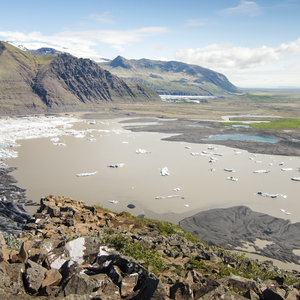You are here
Located on the edge of Vatnajökull National Park, Jökulsárlón is a large glacial lake in the southeastern part of Iceland. The name means “glacial river lagoon,” and it is positioned at the head of Breiðamerkurjökull; a massive glacier towering over 910 meters (3,000 feet) high. It is approximately 5 kilometers (3 miles) wide and is the deepest lagoon in Iceland with water than can be up to 250 meters (820 feet) deep. These depths attract herring and trout from the ocean, which will sometimes bring seals, porpoises, and other small whales inland.
Massive, translucent icebergs float across the water that are pieces of glacial remains formed centuries ago. In the sunlight they appear with a bright blue translucent color as the microscopic crystals refract the colors of the landscape and water. Their vibrancies are backed by dark shades and milky whites representing a blend of volcanic ash and trapped air. Tide currents in the water cause them to break apart and fluctuate, never completely freezing over. Larger chunks become entrenched at the mouth of the river while the smaller ones pass out to sea. Sometimes they wash up onto shore in large chunks where you can investigate their intricacies that were once submerged.
There are several miles of unofficial dirt paths that extend around the moraines; rocks and sediments carved out and placed by the movement of the glacier. The bird life is prolific here, and artic terns can be seen nesting on the ground along with arctic skuas. They migrate from their wintering grounds off the coasts of Spain and Africa and are not afraid of human beings, so do not get close to their nests.
Jökulsárlón only developed about 60 years ago when the entire lagoon spanned less than 30 meters (100 feet) from the base of the glacier. Vatnajökull extended to the shore and dropped icebergs into the ocean. Since then however, it started drifting inland very rapidly. In 1975, the lake was about 8 square kilometers (3 sqquare miles) in area, and now it measures approximately 18 square kilometers (6.9 square miles); it has increased its size by a multiple of four.
Boat tours are a main feature of the area and are the best way to explore the lagoon. They bring you close enough to the icebergs to taste the 1,000 year-old ice! A guide will share some information about the glacier and surrounding region. Rides last about 40 minutes and operate between April and October. Check out their website for more specific times and details.
The lake is between Höfn and Skaftafell and accessible via Route 1. All buses traveling along the southern coast of the country stop here for about 30-minutes, which allows you plenty of time to take in the scenery and walk around some of the landscape. It is a very popular time throughout the year, and it can be quite crowded in the summer. On site there is a visitor center a café and souvenir shop. You can also cross over the highway and explore the Diamond Beach, where smaller chunks of ice will move along the shore with the waves.








Comments
Sign In and share them.